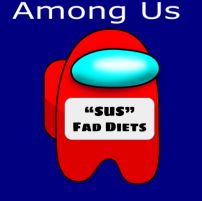
Are your students obsessed with the video game “Among Us”? Mine are! So, I thought if I used a concept from the game in a lesson, it would pique their interest! Fad Diets “Among Us” does just that as students learn about “sus” claims that are touted by fad diets. The lesson continues as students learn how to spot fad diets and utilize what they’ve learned as they analyze a fad diet advertisement.
Set
- Intro by having students play the Among Us: Vote the Imposter. Which one looks “sus” when it comes to diet plans?
- Print the Slides “Among Us” as posters. Hang them around the room. Ideally, place students in small groups of 2-3. Have them circulate around the room and look at the claims. Discuss which claim is the imposter and identify by slide # and crewmate color. Justify why you/group picked the answer you did and fill out the form.
- Discuss student selections and justification responses as a class.
Materials
- iPads or Laptops
- Projector & Screen
- Printed “Among Us” Slides
- Laminated Diet Plan Examples (optional)
Activities
- After discussing the claims in the Among Us activity, ask students if they knew that all of the “sus” imposter claims were associated with fad diets.
- To learn more, provide students with this infographic, “Too Good to be True” and ask them to read and analyze it before completing the analysis template.
- Review the information with students and ask them why they think people turn to fad diets.
- Explain that fad diets are eating plans that are popular for a period of time, that do not follow dietary guidelines established by credible health sources and often have unrealistic rules and results. Many people turn to them because they want quick/amazing results, have tried everything else with no success, believe what they read, are desperate, and the list goes on!
- At this point, we explore “How to Spot a Fad Diet” via the Ted Talk. Since fad diets make unrealistic claims about their products/programs and include “suspicious” warning signs or red flags, we need to be able to recognize them. One resource I share with them is “Don’t Fall Victim to Fad Diets” from Food & Health Communications. Additional red flags or warning signs we talk about include:
- Rapid weight loss promises
- Sounds too good to be true
- Limited food choices or dietary restrictions (ex. Twinkie Diet)
- Excludes entire food groups
- Includes supplements, shakes, bars, meals, magic pills, herbs, etc.
- No exercise or new behaviors required
- Testimonies showing before/after photos unrealistic or atypical for the average person
- Endorsed by famous celebrities, athletes or well known individuals
- Sound scientific, but no data or evidence to support it
- The point I really try to drive home to my students is to think about a healthy lifestyle, not diet. I share an Infographic from the American Heart Association as to what healthy diets should be.
- Another review is done over this information via a Quizizz game.
- Depending on how students did with the intro activity regarding the claims, you could go back and revisit the claims, discussing why each is or is not related to fad diets.
- Finally, I pass out sample diets laminated from older magazine advertisements (one per group or individual) and have students individually or in a small group analyze for healthfulness. I have them keep track of the “sus” claims/red flags it contains and use the infographic from above to determine if the “diet” is healthy or not and summarize why. We discuss them afterward. Note: The ads are older and I tell my students that, however, they do illustrate just how crazy and extreme diets can be/have been. I also tell them, that some of these plans may no longer exist because of how unhealthy they were.
- Because my examples are older, students then complete the Fad Diet Project using more current diets. Using the same criteria, students analyze them for healthfulness once complete.
Attachments
- Imposters Among Us (PDF)
- Analyzing the Infographic Template (please make a copy)
- Fad Diet Ad #1 (PDF)
- Fad Diet Ad #2 (PDF)
- Fad Diet Ad #3 (PDF)
- Fad Diet Ad #4 (PDF)
- Fad Diet Ad #5 (PDF)
- Fad Diet Ad #6 (PDF)

